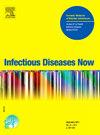对肺功能受损的 COVID-19 复发者的一年随访:前瞻性队列研究
IF 2.9
4区 医学
Q2 INFECTIOUS DISEASES
引用次数: 0
摘要
一氧化碳弥散能力(DLCO)降低是 COVID-19 复发者中最常见的肺部检测异常。我们在 COVID-19 后平均 3 个月对 51 名 DLCO 受损者进行了前瞻性随访,并在一年后对他们进行了复查。随访期间,DLCO 平均值从 68.0% 上升至 72.6%(p = 0.002);虽然有 33% 的患者 DLCO 出现了临床意义上的显著上升(>10 点),但只有 29% 的患者 DLCO 值恢复正常。虽然 DLCO 的变化与症状无关,但缺乏改善在肥胖患者中更为普遍。无论 COVID-19 的严重程度如何,很大一部分人在 1 年后仍表现出 DLCO 受损。本文章由计算机程序翻译,如有差异,请以英文原文为准。
One-year follow-up of COVID-19 recoverees with impaired pulmonary function: A prospective cohort study
Decreased diffusion capacity for carbon monoxide (DLCO) is the most prevalent pulmonary testing abnormality among COVID-19 recoverees. We prospectively followed 51 individuals with impaired DLCO at an average of ∼3 months following COVID-19 and re-examined them at one year. At follow-up, mean DLCO increased from 68.0 % to 72.6 % (p = 0.002); while 33 % of the cohort experienced a clinically significant rise (>10 points) in DLCO, only 29 % normalized their values. While DLCO change did not correlate with symptoms, lack of improvement was more prevalent among individuals with obesity. Regardless of COVID-19 severity, a substantial proportion continued to exhibit DLCO impairment at 1-year.
求助全文
通过发布文献求助,成功后即可免费获取论文全文。
去求助
来源期刊

Infectious diseases now
Medicine-Infectious Diseases
CiteScore
7.10
自引率
2.90%
发文量
116
审稿时长
40 days
 求助内容:
求助内容: 应助结果提醒方式:
应助结果提醒方式:


